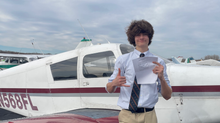The Hidden Costs of Aircraft Ownership: Unraveling the Neglected Maintenance Legacy

Aircraft ownership is an exciting and rewarding venture, but for many owners, it comes with an unexpected challenge—addressing the deferred maintenance left behind by previous owners. While purchasing an aircraft may seem straightforward, the reality is that years of postponed repairs and overlooked maintenance issues can turn ownership into an expensive and time-consuming ordeal.
Inherited Maintenance Challenges
Many aircraft change hands multiple times throughout their operational life, and with each transition, some maintenance issues are inevitably pushed down the road. Deferred maintenance—the practice of postponing necessary inspections, repairs, or overhauls due to cost or operational convenience—accumulates over time, creating a backlog of issues that the next owner must address.
This phenomenon is well documented in general aviation. According to a report from the Federal Aviation Administration (FAA) Office of Aviation Safety, deferring maintenance increases operational risks and leads to higher long-term costs due to progressive wear on critical components (FAA, 2023).
Common issues encountered in pre-owned aircraft include:
Aging avionics and electrical systems that do not meet current standards or have intermittent failures.
Hidden corrosion in airframes, particularly in aircraft stored in humid or coastal environments.
Engine wear and tear that may require premature overhauls due to oil contamination or poor maintenance practices.
Landing gear and hydraulic system issues resulting from fluid leaks, worn-out seals, or inadequate servicing.
These are not just minor inconveniences—they directly impact an aircraft’s safety, performance, and long-term reliability.
The True Cost of Prolonged Maintenance Downtime
Aircraft owners often underestimate the cost of downtime when an aircraft is undergoing extensive repairs. A single unexpected issue can turn what should be a short annual inspection into a months-long maintenance saga. According to a study by AOPA’s Air Safety Institute, nearly 40% of aircraft owners experience downtime exceeding three months when dealing with maintenance surprises after purchase (AOPA, 2022).
The financial impact is twofold:
Lost Revenue and Productivity – For flight schools, charter operators, and business owners, extended downtime translates to lost revenue opportunities. A non-operational aircraft means fewer flight hours, disrupted training schedules, and increased reliance on leased or rented aircraft.
Escalating Repair Costs – What starts as a minor repair can quickly snowball into a major overhaul. Deferred maintenance often leads to cascading failures in interconnected systems, requiring costly parts replacement and additional labor hours.
Mitigating the Risk: Pre-Purchase Due Diligence
To avoid inheriting years of neglected maintenance, prospective buyers should conduct thorough pre-purchase inspections and review logbooks with a discerning eye. Key steps include:
Hiring an experienced aircraft mechanic or A&P/IA (Inspection Authorization) to conduct a pre-buy inspection. A standard annual inspection is insufficient; a deeper assessment of corrosion-prone areas, hidden structural issues, and engine health is essential.
Verifying maintenance logbook entries for gaps or inconsistencies. Missing records or vague entries about major repairs should raise red flags.
Checking for compliance with Airworthiness Directives (ADs) and Service Bulletins (SBs). Deferred compliance can result in costly grounding or unplanned repairs.
Assessing avionics upgrades and FAA-mandated equipment. Older avionics may not meet ADS-B requirements, and outdated systems may need expensive upgrades to remain airworthy.
According to a National Business Aviation Association (NBAA) guide on pre-owned aircraft transactions, nearly 25% of all aircraft buyers encounter unexpected costs due to incomplete or misleading maintenance records (NBAA, 2023).
Planning for Inevitable Downtime
Even with careful pre-purchase planning, maintenance downtime is an unavoidable part of aircraft ownership. To minimize disruptions:
Budget for unforeseen repairs. Having a maintenance reserve fund equivalent to 10-20% of the aircraft’s value can prevent financial strain when major repairs arise.
Establish relationships with reliable maintenance shops. Finding an experienced mechanic who understands your aircraft model can expedite repairs and reduce costs.
Consider shared ownership or leasing options during downtime. Flight schools and private owners often benefit from leasing aircraft temporarily when their primary aircraft is in maintenance.
Final Thoughts
Owning an aircraft is not just about the joy of flight—it’s about understanding the full lifecycle of maintenance responsibilities. While the thrill of acquiring an aircraft can overshadow practical considerations, the reality of inherited maintenance issues and prolonged downtime quickly sets in. Smart owners recognize that due diligence, proactive planning, and a realistic maintenance budget are just as important as a well-executed landing.
Aircraft ownership should be an asset, not a burden. By addressing deferred maintenance head-on and preparing for downtime, owners can ensure their aircraft remains a reliable and enjoyable tool for years to come.
By Doug Auclair
References
Aircraft Owners and Pilots Association (AOPA). (2022). General aviation maintenance report: Understanding downtime and costs. Retrieved from https://www.aopa.org
Federal Aviation Administration (FAA). (2023). Aviation safety: Risks of deferred maintenance in general aviation. Retrieved from https://www.faa.gov
National Business Aviation Association (NBAA). (2023). Pre-owned aircraft transactions and maintenance due diligence. Retrieved from https://www.nbaa.org




























